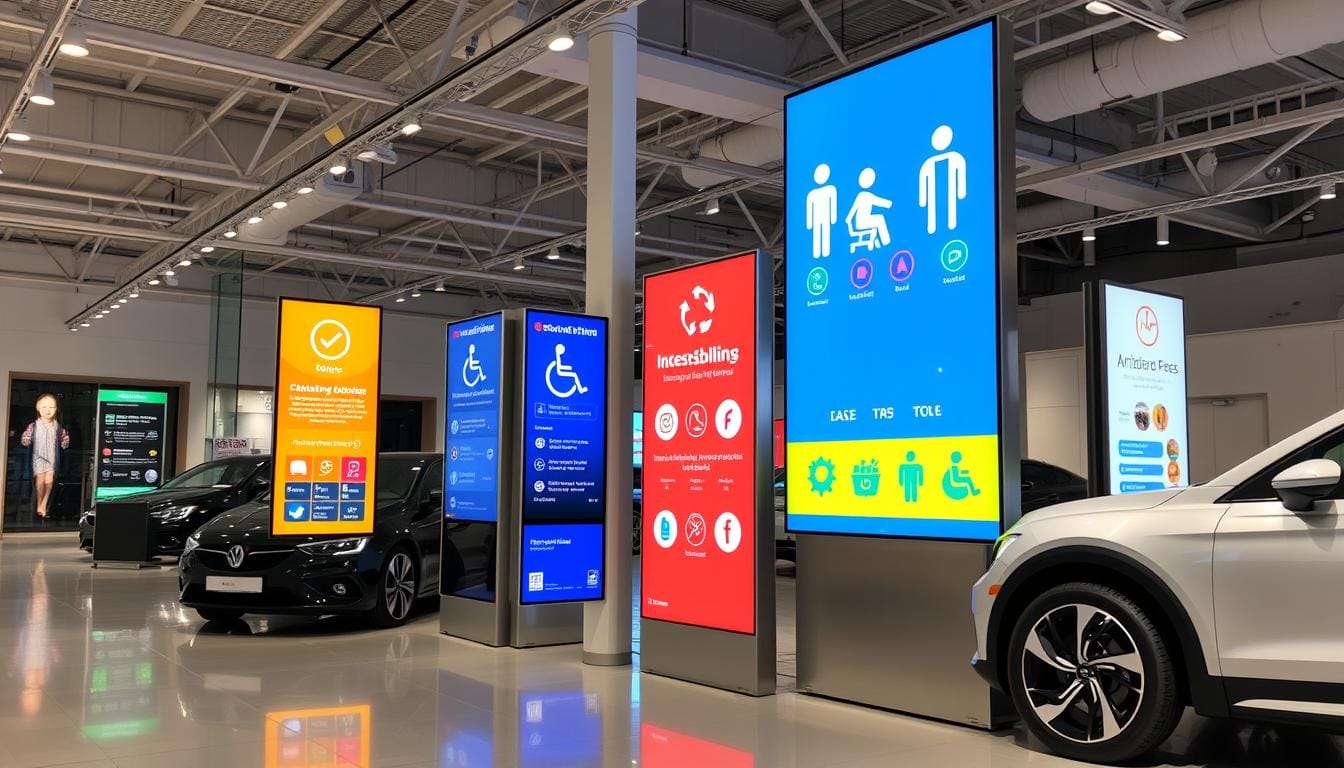Did you know about 1.3 billion people worldwide have disabilities? This is about 16% of the population needing help every day. Digital signs in cars can make driving better for everyone, offering clear advantages.
Using design that includes everyone helps those with hearing, vision, or cognitive disabilities. It also meets ADA rules. This way, digital signs in cars can help a wide range of people, promoting fairness and inclusion.
Key Takeaways
- Globally, 1.3 billion individuals live with disabilities, highlighting the need for accessible automotive digital signage.
- ADA standards ensure digital signage does not protrude more than 4 inches from the wall and is placed between 27 and 80 inches from the ground.
- Voice-responsive technology and other assistive features on digital signage support equitable in-vehicle user experiences.
- Incorporating braille instructions and high-contrast displays can greatly enhance usability for visually impaired users.
- Multimodal digital signs integrate visual, auditory, and tactile elements for diverse user engagement.
The Role of Inclusive Experiences in Modern Automobiles

In the world of modern automobiles, making experiences inclusive is key. The car industry is changing fast, thanks to digital tech. This change includes using digital signage in vehicles to make cars more welcoming and connected.
Importance of Digital Signage in Vehicles
Digital signs in cars help make driving better for everyone. They show important info and safety tips, making the ride more fun and safe. Since digital tech is a big part of a car’s value, it’s clear how important it is.
Car makers now update their cars faster, thanks to digital signs. This means they can change software and content easily to meet what people want.
Benefits of Inclusive Automotive Digital Signs
Digital signs in cars have many good points. They help show different cultures and needs, making everyone feel welcome. They also make cars more connected and smart, like with self-driving tech.
This tech makes cars better for everyone. It also helps car makers save money and be more creative. Electric cars and digital tech are changing how we buy and use cars, making it more fun and interactive.
| Benefit | Impact |
|---|---|
| Real-time Information | Enhances safety and driving efficiency |
| Personalized Content | Improves driver engagement and satisfaction |
| Diverse Representation | Promotes cultural awareness and inclusivity |
By focusing on inclusive experiences, cars are becoming more than just a way to get around. They’re about making a journey that’s fun and respectful for everyone, setting a new standard in the car world.
Accessibility Considerations in Automotive Digital Signs
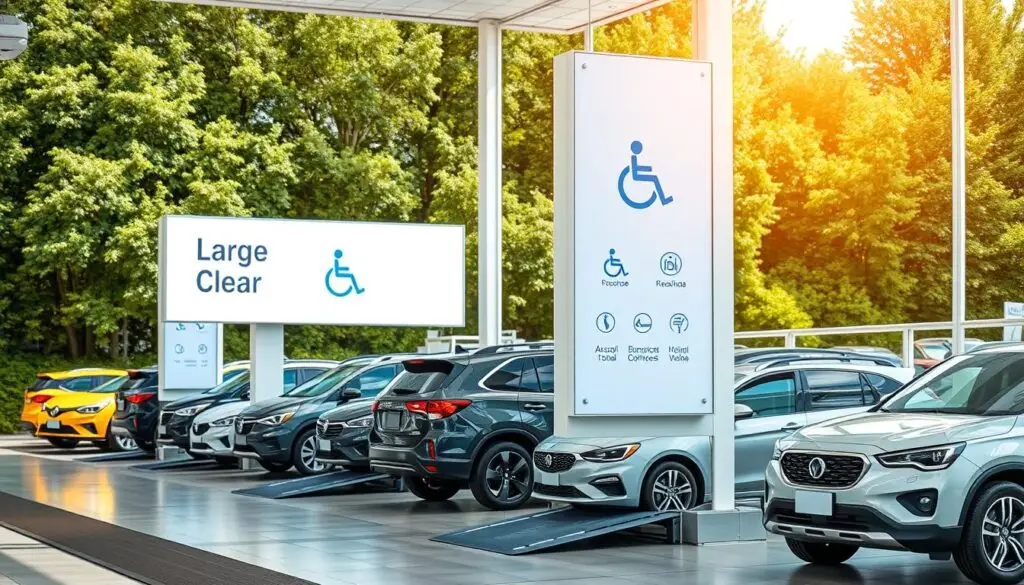
Automotive digital signs are becoming more common. It’s important to make sure they are accessible to everyone. About one in four American adults has a disability. Not following the Americans with Disabilities Act (ADA) can lead to legal and financial problems.
Accessible User Interfaces
User interfaces in automotive digital signs need to be accessible. They should be easy to reach and installed at the right height. Touch screens and gesture controls make it easier for people with disabilities.
Adding audio features helps those who can’t see. This makes the system friendly for everyone.
Voice User Interfaces (VUIs)
VUIs are key for accessibility in digital signs. They let users control the signs with voice commands. This is great for those with physical or visual issues.
VUIs also offer a hands-free option. This makes using the signs safer and more convenient for everyone.
Screen Readability and Interaction
Screen readability is crucial for accessibility. The ADA says text should be between 5/8 and 2 inches tall. The color contrast should be at least 3:1 for clear reading.
Using clear and bright visuals helps those with hearing problems. By focusing on text size, contrast, and controls, digital signs can be more user-friendly. This helps businesses reach more people and improve satisfaction.
Assistive Technologies in Vehicles
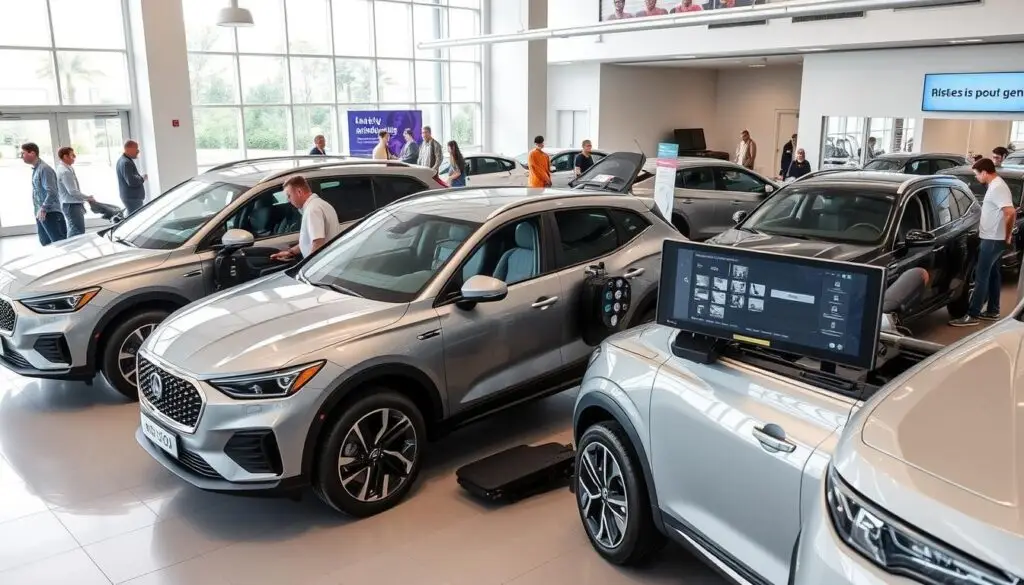
Assistive technologies in vehicles are changing how we think about cars for everyone. They include screen readers, braille displays, and voice interfaces. These tools help people with disabilities drive more easily and safely.
Car makers are working hard to make cars for everyone. They’re adding smart wheelchairs with sensors and GPS. These wheelchairs help users move around safely and find their way.
These technologies go beyond just moving around. Robotic exoskeletons help people walk again. Augmented Reality (AR) systems give directions and help find the best paths for wheelchair users.
Wheelchair accessible vehicles (WAVs) are a big step forward. They have ramps and lifts for easy entry. WAVs also come with telehealth features for health monitoring on the go.
But, there are still big challenges. Things like cost, fitting the technology into cars, and changing buildings are hard. Working together, we can solve these problems and make cars better for everyone.
Assistive technologies in cars are making a big difference. They give people with disabilities the chance to be independent. By keeping innovating, we can make cars that everyone can use.
| Technology | Function | Benefit |
|---|---|---|
| Smart Wheelchairs | Sensors, GPS, Networking | Enhanced navigation and obstacle detection |
| Robotic Exoskeletons | Lower Limb Mobility Support | Enables standing, walking, and moving |
| Augmented Reality Navigation | Real-time Directions and Assistance | Accessible route finding |
| Wheelchair Accessible Vehicles (WAVs) | Ramps, Lifts, Accessibility Features | Comfortable and hassle-free travel |
| Telehealth Technologies | Remote Monitoring Systems | Real-time healthcare assistance |
Inclusive Design for In-Car Displays

Inclusive design for in-car displays is key to making automotive HMIs better for everyone. It focuses on universal design principles. These ensure that users with different abilities can access the system easily.
Universal Design Principles for Automotive HMIs
Following universal design principles makes automotive HMIs more user-friendly. It means creating clear, easy-to-use interfaces. This reduces the mental effort needed by the driver.
Volkswagen Group of America started its inclusive mobility initiative in 2017. It aims to improve mobility for people with disabilities through new car designs.
Flexibility and Customization
Flexibility and customization in vehicles are vital. They let users change their in-car displays to fit their needs. This includes adjusting font sizes and contrast for those with vision problems.
It also includes providing tactile notifications for deaf passengers. Plus, integrating smartphone features into IVI systems adds music streaming, navigation, and hands-free messaging. This shows how flexible and customizable these systems can be.
| Initiative | Focus |
|---|---|
| Volkswagen Inclusive Mobility | Improving mobility for people with disabilities |
| Software Interfaces | Developing screen reader accessibility |
| Tactile Notifications | For deaf passengers |
| Seat Arrangements | Enhanced communication for deaf passengers |
Multimodal Interaction in Automotive UX
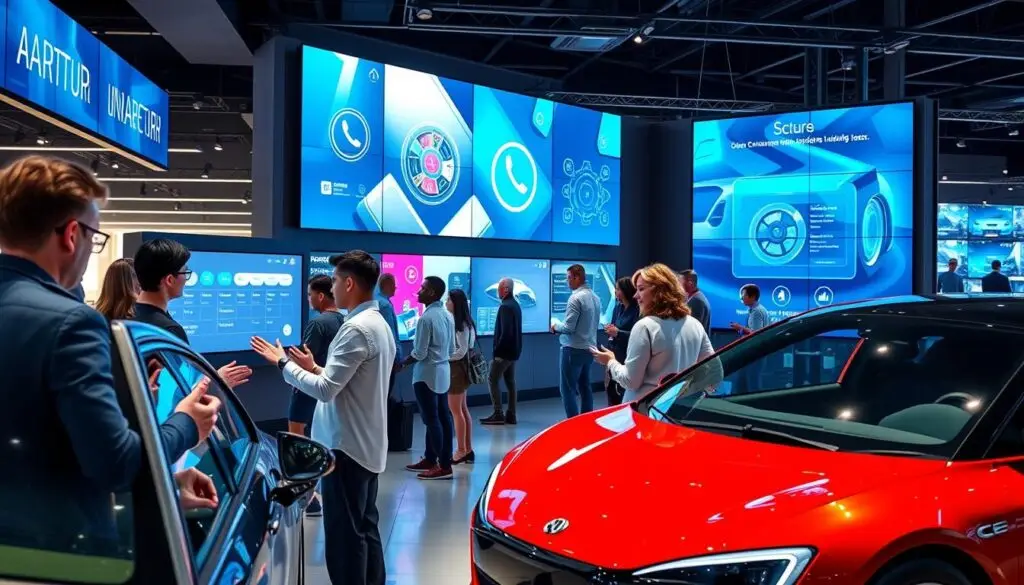
Automotive technology keeps getting better, making multimodal interaction key for better user experience (UX) in cars. By mixing visual, auditory, and tactile feedback, these systems make driving and riding more fun and easy for everyone.
Combining Visual, Auditory, and Tactile Feedback
At the heart of automotive UX is using many ways to interact. Visual feedback comes from clear displays and HUDs, giving drivers the info they need without taking their eyes off the road. Auditory feedback uses smart voice systems like Siri and Alexa, letting users control things without their hands.
Tactile feedback is also important, with touchscreens and haptic tech becoming common in cars. This feedback gives drivers physical responses, making interactions better and cutting down on the need to look at screens.
Adaptive Systems for Enhanced Engagement
Adaptive systems are key for the future of car interfaces. They learn what users like and need, making experiences better and more personal. For example, they can change things like climate control and music based on what you like.
These systems also make cars more accessible for people with disabilities. They understand and meet different needs, making cars more comfortable and independent for everyone. This makes driving more inclusive and enjoyable for all.
These advanced technologies don’t just make driving more fun. They also make cars safer and more accessible for everyone. By using multimodal interaction and adaptive systems, the future of car interfaces looks bright. It promises to change how we interact with our vehicles, making driving better for everyone.
Accessible Automotive Infotainment Systems
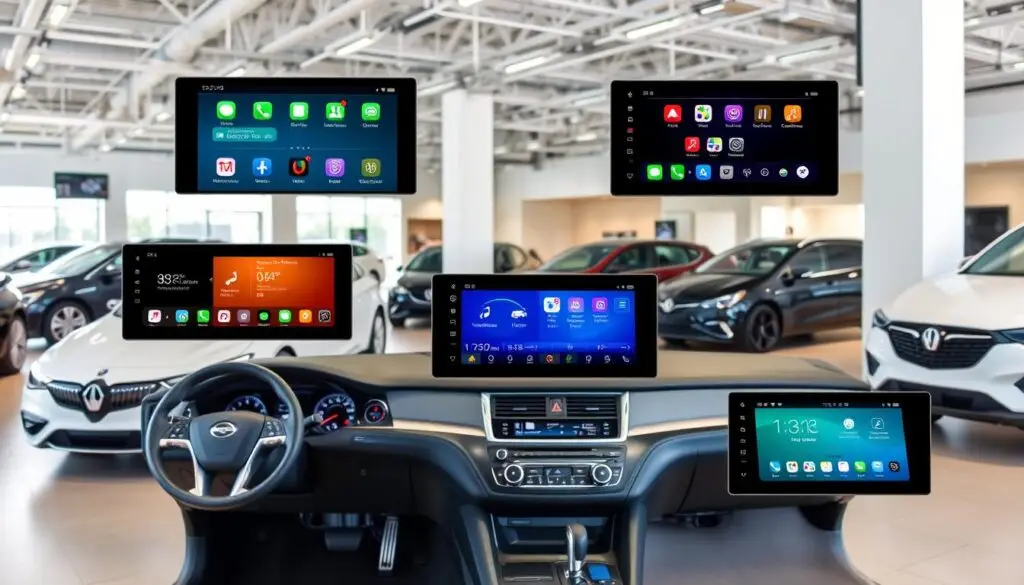
The world of car infotainment is changing, focusing more on making things accessible. In the U.S., the Americans with Disabilities Act (ADA) and in the European Union, the Web Accessibility Directive push for digital products that everyone can use. This means making accessible infotainment systems that meet different needs.
For people with vision problems, features like adjustable font sizes and high-contrast displays are key. These systems make sure the text is easy to read by following specific contrast ratios. This ensures that everyone can use the infotainment system without trouble.
Hearing loss affects many, so features like closed captioning and sound enhancements are crucial. These help make the experience better for everyone, showing a strong commitment to automotive accessibility.
Mobility issues also need to be addressed, with customizable touchscreens and voice commands. For example, older adults need bigger buttons and simpler menus. This makes using the car’s technology easier and more enjoyable.
Cognitive and speech disabilities require intuitive interfaces and advanced speech recognition. Testing these systems with people with disabilities is key to making them better. This ensures that accessible infotainment systems meet everyone’s needs.
Today’s infotainment systems have grown from simple radios to complex multimedia centers. They offer entertainment, navigation, and more. These advancements benefit not just those with disabilities but everyone, making the car experience better and more customizable.
| Accessibility Feature | Importance | Implementation |
|---|---|---|
| High-Contrast Displays | Essential for low vision users | Mandated by accessibility guidelines |
| Voice Commands | Critical for mobility and speech-impaired users | Integrated in most modern infotainment systems |
| Adjustable Font Sizes | Supports visual impairments | Customizable in many systems |
| Closed Captioning & Subtitles | Vital for users with hearing loss | Available in media playing functionalities |
| Customizable Touchscreens | Helps users with mobility challenges | Incorporated through user settings |
Adding these features not only meets legal requirements but also improves the driving experience. It shows that making cars accessible is a key part of modern user-friendly vehicle technology.
Disability-Friendly Vehicle Interfaces

Disability-friendly vehicle interfaces are changing the car world. They make driving easier for more people. In the US, about 1 in 5 people have a disability. This means over 57 million people could benefit from these changes.
Adaptive automotive design aims to let people with disabilities drive safely. It includes features like easy-to-use controls and smart interfaces. For example, cars with screens that feel like touch or respond to voice commands help those who can’t see or move well.
Car makers are now focusing on making cars easier to use. They use voice commands and physical changes like steering aids. The goal is to help drivers with disabilities feel confident and independent.
Groups like the National Highway Transportation Safety Administration (NHTSA) are taking notice. They’ve made rules for self-driving cars. Places like California have their own rules too. These efforts, like the VTA AAV project, show a big push for cars that everyone can use.
Here’s a quick look at key points about making cars more accessible:
| Feature | Details |
|---|---|
| Ramps | Must have a clear width of at least 30 inches with edge guards at least 2 inches high. |
| Doorways | Must open to a clear width of at least 32 inches and have contrasting color stripes at the bottom. |
| Autonomous Vehicle Regulations | Guidance from NHTSA and regional systems, like California’s graduated regulations. |
| AI and Automation | Used in projects like VTA AAV for better access. |
| Voice and Haptic Interfaces | Technologies from companies like Google make cars easier to control for disabled drivers. |
| Manual Operation | Ramps can be moved by hand if power goes out, supporting 300 or 600 pounds. |
The car industry is working hard to make cars more accessible. This effort means everyone can enjoy the freedom of driving.
Implementing Inclusive Experiences: Accessibility Considerations in Automotive Digital Signs
The automotive industry must focus on making digital signs accessible to everyone. It’s important to make sure these signs follow ADA rules and use universal design. Using the latest technology helps make these systems work for more people.
Placing screens in a way that’s easy to reach and use is key. It’s also important to think about both visual and sound content. This ensures that everyone can understand it. Following guidelines from the World Wide Web Consortium (W3C) helps make digital signs accessible to people with different abilities.
Using artificial intelligence (AI) and machine learning makes digital signs in cars better. For example, Natural Language Processing (NLP) helps make documents more accessible. These changes are important for making cars more inclusive.
Changes in laws, like updates to the Americans with Disabilities Act (ADA), make businesses focus on digital accessibility. The European Accessibility Act also requires digital devices to be accessible. These laws show how important it is to make car digital signs accessible worldwide.
Working together is crucial for making digital signs truly accessible. Companies like Motional are leading the way with new ideas. Making cars accessible to everyone is essential for a fair and inclusive driving experience.
Conclusion
In conclusion, making automotive digital signage more inclusive is a big step forward. It’s not just about new tech; it’s about valuing diversity and making things better for everyone. This change shows the industry’s strong commitment to making cars more accessible and user-friendly for all.
This article has shown how important inclusive design is in car making. By using voice interfaces, multiple ways to interact, and systems that adapt, cars are becoming more accessible. These changes help people with disabilities and make driving better for everyone.
The role of accessible interfaces and universal design in cars is key. The industry is showing that cars can be made for everyone. As we move forward, we need to keep working on making cars better for all. This journey shows that making cars more inclusive is not only possible but also necessary.
FAQ
What are Inclusive Automotive Design Guidelines?
Inclusive Automotive Design Guidelines aim to make vehicle systems work for everyone. They focus on making digital signs and other tech accessible and easy to use. This ensures that all users, including those with disabilities, can enjoy a fair and inclusive experience.
How do Digital Signage Solutions contribute to Equitable In-Vehicle User Experiences?
Digital signage solutions make driving better for everyone. They provide clear, easy-to-understand information. Features like adjustable text and voice commands help everyone use the tech, making driving more enjoyable.
What is the Importance of Digital Signage in Vehicles for Modern Automobiles?
Digital signage is key for modern cars. It makes driving safer and more accessible. It gives real-time info and meets different needs, creating a welcoming space for all.
What are the Benefits of Inclusive Automotive Digital Signs?
Inclusive digital signs offer many advantages. They make cars more accessible for people with disabilities. They also improve the driving experience and support diversity and inclusion.
What are Accessibility Considerations in Automotive Digital Signs?
When making digital signs, accessibility is crucial. Signs should be easy for everyone to use. This includes voice commands, adjustable text, and contrast. It ensures that all users can interact with the car’s systems.
How do Accessible User Interfaces improve automotive experiences?
Accessible user interfaces make cars easier to use. They offer controls that work for everyone. Features like voice commands and high-contrast displays make essential info easy to find, improving satisfaction.
What role do Voice User Interfaces (VUIs) play in automotive accessibility?
Voice User Interfaces (VUIs) are vital for car accessibility. They let drivers and passengers control the car without hands. This is especially helpful for those with disabilities, making the car more accessible.
Why is Screen Readability and Interaction important for Inclusivity?
Screen readability and interaction are key for inclusivity. They ensure that car screens are clear for everyone, including those with vision issues. By making text and design easy to use, cars become more welcoming.
What are Assistive Technologies in Vehicles?
Assistive technologies in cars help people with disabilities. They include tools like voice commands and screen readers. These technologies make driving more accessible and enjoyable for all.
What is the significance of Universal Design Principles for Automotive HMIs?
Universal Design Principles are essential for car HMIs. They aim to make cars accessible to everyone. By designing flexible interfaces, cars can meet the needs of all users, promoting inclusivity.
How do Flexibility and Customization enhance in-car displays?
Flexibility and customization make car displays better. They let users adjust settings to fit their needs. This adaptability ensures that cars can meet the needs of a wide range of users, offering a more personalized experience.
What is Multimodal Interaction in Automotive UX?
Multimodal interaction combines visual, auditory, and tactile feedback. It makes driving more engaging and accessible. By offering different ways to interact, cars can better meet individual preferences, enhancing the driving experience.
How do Adaptive Systems enhance Engagement in vehicle systems?
Adaptive systems adjust to individual preferences and needs. They personalize the car’s interface and provide info in a way that’s easy to understand. This makes driving more enjoyable and intuitive.
What features make Automotive Infotainment Systems accessible?
Accessible infotainment systems have features like high-contrast displays and voice commands. They also support assistive technologies like screen readers. These features make the system easy to use for everyone, offering an inclusive entertainment and information experience.
Why are Disability-Friendly Vehicle Interfaces important?
Disability-friendly interfaces are crucial for car accessibility. They allow people with disabilities to control the car independently. By offering adaptive options and intuitive controls, cars become more accessible to a wider audience.
What are key strategies for Implementing Inclusive Experiences in automotive digital signage?
To create inclusive digital signage, follow ADA standards and universal design principles. Use assistive technologies and ensure that content is clear for all. These strategies help make the car environment welcoming and accessible for everyone.

